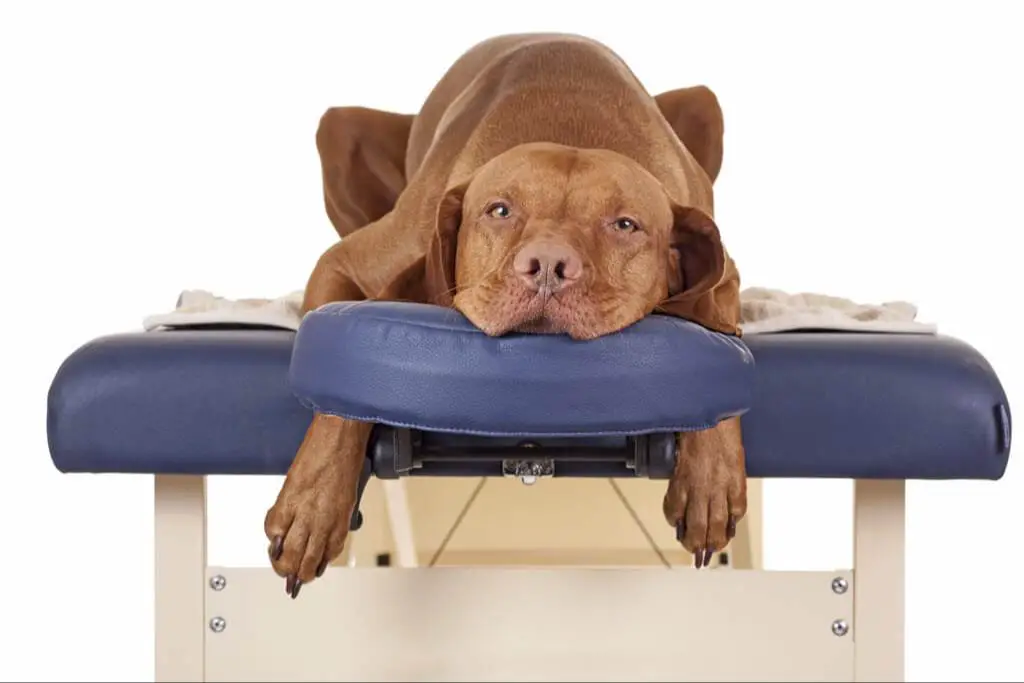Introduction
Many dog owners are now turning to chiropractic treatments as a complement to conventional veterinary care for their furry friends. There are many potential benefits, but there are also important considerations before starting chiropractic care for your dog. In this article, we’ll explore the basics of chiropractic treatments for dogs, how they work and what conditions they can help treat, the risks involved, and how to find a qualified practitioner.
Chiropractic care focuses on detecting and correcting misalignments in the spinal column and musculoskeletal system. Gentle and carefully executed adjustments are made to restore proper alignment and mobility to the joints and spine. The goal is to relieve pain, restore normal nerve function, improve range of motion, and support overall health.
Research suggests that regular chiropractic care may help dogs with certain musculoskeletal, neurological, and spinal conditions. It is considered an alternative therapy that complements traditional veterinary treatments. While generally safe when performed by a properly trained professional, there are some risks to consider. We’ll cover the key benefits and drawbacks to help you determine if chiropractic care is right for your dog.
What is Chiropractic Care?
Chiropractic care is a hands-on, drug-free treatment approach that focuses on the health of the musculoskeletal and nervous systems. Chiropractors use gentle techniques to adjust misalignments in the spine or other joints. These adjustments aim to restore mobility, improve nerve communication, and support the body’s natural ability to heal itself.
The core principle of chiropractic care is that misalignments in the spine, called subluxations, can negatively impact the nervous system. This in turn can contribute to pain, inflammation, and other health issues. Chiropractors manually and gently manipulate the spine to relieve pressure on nerves, restore range of motion, and realign the vertebrae.
In addition to spinal manipulation, chiropractors may use additional techniques such as soft tissue therapy, rehabilitation exercises, or lifestyle counseling. The goal is to treat not just symptoms, but the root cause of musculoskeletal problems.
How Does it Work for Dogs?
Chiropractic care for dogs is based on the same principles as chiropractic care for humans. The theory behind chiropractic is that the body has an innate ability to heal itself. However, sometimes the spine and other joints can become restricted or misaligned, which can affect the nervous system and lead to pain, reduced function, and illness.
Chiropractors perform adjustments on dogs to realign the vertebrae and joints, restoring normal range of motion. This removes any nerve interference caused by the misalignments. When the nervous system is functioning properly, the body is better able to communicate, heal itself, and regulate important systems.
For dogs, chiropractic adjustments are tailored to their specific anatomy. A chiropractor will gently apply controlled force to the joints using their hands. Short lever, low amplitude techniques are often used to deliver precise adjustments without putting too much pressure on the animal.
Following the chiropractic adjustment, the dog’s range of motion and comfort should be improved. Over a series of treatments, their body will be better able to heal itself and maintain proper alignment on its own.
Conditions It Can Treat
Chiropractic care can be an effective treatment option for several common conditions in dogs, including:
Back Pain
Like humans, dogs can suffer from back pain due to injury, age-related changes, or spinal misalignment. Gentle chiropractic adjustments can provide relief by realigning the vertebrae and restoring normal motion.
Arthritis
Osteoarthritis is very common in older dogs. By improving joint mobility and reducing inflammation, chiropractic treatment may help manage arthritis symptoms and improve quality of life.
Injuries
Chiropractic care can aid recovery from injuries like fractures, sprains, and strains by restoring alignment and range of motion. It helps relieve muscle tension and may speed healing.
Other conditions like hip dysplasia, elbow or knee issues, and post-surgical recovery may also benefit from chiropractic adjustments tailored to the dog’s needs.
Benefits
Chiropractic care can provide several benefits for dogs when performed by a qualified professional. Some of the main benefits include:
Relief from Pain
One of the primary reasons pet owners seek chiropractic care is to relieve their dog’s pain. Chiropractic adjustments can help reduce pain and inflammation caused by conditions like arthritis, dysplasia, or injury. Gentle spinal manipulation techniques can improve mobility in the joints and spine to alleviate discomfort.

Improved Mobility
Chiropractic adjustments can also improve range of motion and flexibility in dogs. For senior dogs or those with joint problems, increased mobility enables them to move more freely and easily again. Improved mobility and flexibility is especially beneficial for active or working dogs.
Non-Invasive Approach
Chiropractic represents a drug-free, non-surgical way to treat pain and mobility issues. For dog owners looking to avoid medications or invasive procedures, chiropractic offers a more natural approach. The adjustments use gentle techniques tailored to the dog’s specific needs for a customized treatment plan.
Risks and Considerations
Though chiropractic care is typically very safe for dogs when performed by a certified practitioner, there are some risks to be aware of.
The most serious potential risk is injury if the adjustments are done incorrectly. Only veterinarians or chiropractors who are trained and experienced in working with animals should perform adjustments on dogs. Forceful turning of the neck or back could cause neurological damage or even paralysis.
It’s also important to get an accurate diagnosis from a vet before beginning chiropractic treatment. If the dog has an underlying condition like disk disease or arthritis, forceful manipulation could worsen the problem or cause further injury. Vets can help determine if chiropractic care is appropriate or if other treatment options would be safer and more effective.
Additionally, there is a small risk of muscle strains or sprains, especially if the dog has pre-existing joint or spinal issues. Mild soreness after treatment is common and normal, but any intense or lasting pain could be a sign of injury.
Overall, chiropractic is very low-risk for dogs when done properly by a trained professional. But owners should be aware of potential downsides, especially if the dog has pre-existing medical conditions. Checking with a vet first and choosing an experienced chiropractor are key to minimizing any risks.
How to Find a Qualified Chiropractor
When searching for a chiropractor to work on your dog, it’s important to find someone properly qualified and experienced. Here are some tips:
Licensure: Make sure the chiropractor is licensed to practice in your state. Chiropractors who treat humans do not necessarily have licenses to work on animals. Look for a chiropractor certified by the American Veterinary Chiropractic Association (AVCA).
Vet Referral: Ask your veterinarian if they have any chiropractors they recommend or work with regularly. Many vets have established relationships with qualified animal chiropractors.

Experience with Dogs: Choose a chiropractor with extensive experience treating dogs specifically. Adjustment techniques can vary between species, so you want someone well-versed in canine anatomy and musculoskeletal issues.
The right chiropractor will have the proper training, technique, and record of success treating dogs similar to yours. Don’t hesitate to ask about their background, certification, methods, and past results before booking your dog’s first appointment. With a skilled chiropractor, your dog stands to benefit greatly from this holistic treatment approach.
What to Expect at Appointments
When you take your dog to a chiropractic appointment, the visit will likely involve an exam, adjustments, stretches, and exercises. Here’s a closer look at what you can expect:
Exam – The chiropractor will do a hands-on exam, feeling along the dog’s spine and limbs. They check for areas of restriction, inflammation, and misalignment. The chiropractor also assesses posture, range of motion, and gait.
Adjustments – The most common chiropractic technique for dogs is called veterinary spinal manipulative therapy (VSMT). The chiropractor uses gentle, controlled force to move the joints of the spine. The goal is to restore normal joint motion and stimulate the nervous system.
Stretches – Certain stretches may be recommended to increase mobility, improve function, and relieve muscle tension. For example, gently extending the legs backward one at a time.
Exercises – The chiropractor may suggest specific exercises to strengthen muscles, enhance flexibility, improve balance and coordination. Things like walking over poles, weaving around cones, or balancing on an exercise ball.

Cost of Chiropractic Care for Dogs
Chiropractic care can be somewhat costly for dog owners, with price ranges typically between $35 to $120 per session depending on your location and the chiropractor.
Most pet insurance plans do not cover chiropractic care, since it is still considered an alternative therapy. However, some plans may offer reimbursement if the chiropractic care is used to treat a covered condition.
Some factors that influence cost are:
- Geographic location – Urban areas tend to have higher rates
- The chiropractor’s experience and qualifications
- Length and number of sessions needed
Prior to starting a treatment plan, be sure to get a clear estimate of costs from the chiropractor. Some may offer bundled discounts for multiple sessions. While chiropractic care does require an investment, it can provide significant benefits for dogs’ comfort, mobility and quality of life.
The Bottom Line

When considering chiropractic care for your dog, weighing the potential benefits and risks is important. On the plus side, research shows chiropractic adjustments can be effective for treating certain conditions in canines, such as back pain, osteoarthritis, hip dysplasia, and mobility issues. It offers a drug-free way to address these problems and may provide noticeable pain relief. Some veterinarians even recommend chiropractic alongside conventional treatments.
However, chiropractic comes with some drawbacks to consider as well. The benefits are not scientifically proven for all conditions, and there are risks if not performed properly. It can be difficult to find a qualified animal chiropractor with the right training and experience. You’ll also need to commit to regular appointments for ongoing adjustments and results. And chiropractic care does not come cheap – expect to spend $50 or more per session.
Overall, chiropractic adjustments may be a helpful complementary treatment for dogs with certain musculoskeletal and neurological issues. But make sure to consult your vet, find a reputable chiropractor, and weigh the time and money required against potential benefits. Proceed cautiously and monitor your dog’s response. When in doubt, the safest approach is to stick with conventional veterinary advice and care.